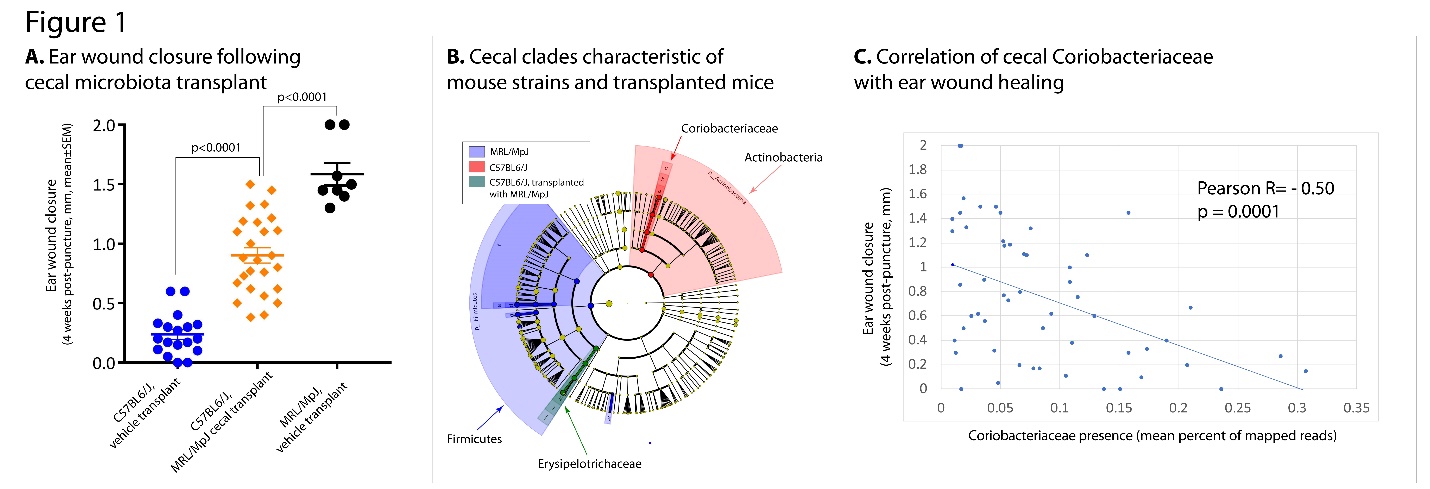Session Information
Session Type: ACR Poster Session C
Session Time: 9:00AM-11:00AM
Background/Purpose: MRL/MpJ mice are substantially protected from developing post-traumatic osteoarthritis (OA), a trait with strong correlation to the ability to heal ear wounds. Previous studies have shown murine ear wound healing to be genetically determined. A powerful role of the gut microbiome in OA has recently been suggested, with dietary oligofructose supplementation resulting in protection from OA. In this study, we examined whether ear wound healing in MRL mice is associated with gut microbiota changes, and whether microbiome transplantation can transfer this superhealer trait.
Methods: Three-week-old C57BL6/J mice were inoculated by oral gavage with diluted cecal contents from adult male MRL/MpJ mice, or with vehicle control. Six-week-old transplanted B6 mice (n=26), age-matched B6 (n=18) and vehicle control MRL mice (n=8) received a 2mm ear punch. Mice were sacrificed 4 weeks later, final earhole size measured, and DNA extracted from cecal contents. The gut microbiome was characterized by 16s rRNA gene deep sequencing and analyzed using QIIME 1.9.1. Group significance-values and FDR-corrected q-values were calculated in QIIME using Kruskal-Wallis and Benjamini-Hochberg. Characteristic clades of each group were calculated and plotted in LEfSe. Microbiome clades were correlated with earhole closure via Pearson correlation.
Results: As previously reported, MRL ear wounds closed well (earhole closure, mm, MRL: 1.6±0.1mm mean±SEM vs. B6:0.23±0.04, p<0.0001). Transplanted B6 mice closed roughly one-half as well as MRL (MRL->B6: 0.9±0.06 vs. MRL: 1.6±0.1, p<0.0001), but significantly more than B6 controls (p<0.0001), (Figure 1A). Microbiome analysis demonstrated several clades that were characteristic of each group (Figure 1B); specifically in MRL and transplanted mice, increases in Lachospiraceae (B6 mean OTU count 0.05 vs. transplant 4.4 vs. MRL 9.4, p=1E-5, q=0.003), Peptostreptococcaceae (B6 0.28 vs. transplant 0.46 vs. MRL 7.6, p=eE-4, q=0.02, and decreases in Coriobacteriaceae (B6: 10670 vs. transplant: 4982 vs. MRL: 795, p=0.0007, q=0.02) and Erysipelotrichaceae (B6: 0.33, transplant 3.2, MRL 2, p=0.002, q=0.05) were seen. The presence of several clades was highly correlated with earhole closure rates in individual mice, including Coriobacteriaceae (Pearson R=-0.53,p=3.5E-5), Figure 1C.
Conclusion: Superhealer MRL mice have substantial differences in gut microbiota composition compared to nonhealer B6 mice. The MRL cartilage healing trait, as measured by earhole closure, is partially transferrable to B6 mice via a gut microbiome transplant, and associated with shifts in specific gut microbiotic taxa. Future work should focus on elucidating the causal mechanism underlying these findings, and further examine the therapeutic potential of gut microbiota modification in treatment of OA.
To cite this abstract in AMA style:
Dunn C, Velasco C, Andrews M, Rivas A, Jeffries MA. Murine Ear Wound Cartilage Superhealer Trait Is Associated with Gut Microbiota Changes and Is Transferable to Non-Healer Mice By Gut Microbiome Transplant [abstract]. Arthritis Rheumatol. 2018; 70 (suppl 9). https://acrabstracts.org/abstract/murine-ear-wound-cartilage-superhealer-trait-is-associated-with-gut-microbiota-changes-and-is-transferable-to-non-healer-mice-by-gut-microbiome-transplant/. Accessed .« Back to 2018 ACR/ARHP Annual Meeting
ACR Meeting Abstracts - https://acrabstracts.org/abstract/murine-ear-wound-cartilage-superhealer-trait-is-associated-with-gut-microbiota-changes-and-is-transferable-to-non-healer-mice-by-gut-microbiome-transplant/

